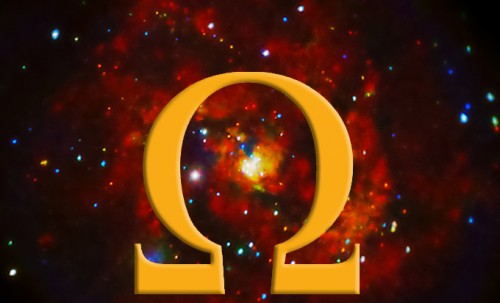Guest post by Mike McFarland Jesus as Omega gently pulls us by person-to-person love to the future, the fullness of the Kingdom of Heaven. You can imagine a solid cone, pointed up. The cords of God’s love stretch from the Omega Point to us. The cords make up the solid cone. Like a 3D graph, the axis of time passes vertically through Omega. We stand at the base of the cone. On the cords of God’s love, Jesus at the apex pulls. As a result, we move both up and closer together. In the second, significantly more “realistic” – both in the popular sense and from a historical viewpoint – and more consistent with scripture, of two hypotheses concerning the way in which we meet Omega :
Jesus as Omega gently pulls us by person-to-person love to the future, the fullness of the Kingdom of Heaven. You can imagine a solid cone, pointed up. The cords of God’s love stretch from the Omega Point to us. The cords make up the solid cone. Like a 3D graph, the axis of time passes vertically through Omega. We stand at the base of the cone. On the cords of God’s love, Jesus at the apex pulls. As a result, we move both up and closer together. In the second, significantly more “realistic” – both in the popular sense and from a historical viewpoint – and more consistent with scripture, of two hypotheses concerning the way in which we meet Omega :
In this second hypothesis, which is more in conformity with
traditional apocalyptic thinking, we may perhaps discern three
curves around us rising up at one and the same time into the
future : an inevitable education in the organic possibilities of
the earth, an internal schism of consciousness ever increasingly
divided on two opposite ideals of evolution, and positive attraction
of the centre of centres at the heart of those who turn towards it. [Italics added.]
[The Phenomenon of Man, Book 4, Chapter III: “The Ultimate Earth”; page 289.]
[See also The Phenomenon of Man, Book 4, Chapter II: “Beyond the Collective, the Hyper-Personal”.] We can repeat after Flannery O’Connor, “All that rises must converge.”
Situated with us and yet at the end of time, Our Lord urges us to relate to those we encounter, with personal love. Also, he urges us to love God with all we are. We pray, “Thy Kingdom come; Thy will be done, on earth as it is in heaven.” Daily, the Father hears this prayer from hundreds of millions of Christians. Our Father responds: sovereignly and with an infinitely greater consciousness than ours, He arranges advancements toward the fullness of the Kingdom of Heaven. We move up toward Omega.
In the Phenomenon of Man, Teilhard presents a vision based on reality – a realistic vision. He writes the book as a scientist. He bases it on what he finds as a paleontologist. He writes what he sees as a human observer trained as a scientist. Teilhard shows the reader what has happened. Then, since the past has taken billions of years, what he writes about the near future becomes like the present. When he writes about the Omega, he logically extends the past. Like John the Baptist, Teilhard heralds the coming of the Most Real.
Applying a little simple relativity to the process outlined by Teilhard, we become the observer. Now let’s look at the development of God’s kingdom. As the kingdom moves ever closer, as the Center of Centers attracts our hearts, we edge closer and closer to the Omega. During this process, what do we see? From our point of view? This is not hypothetical. This is Teilhard’s vision and it is not an ideal. This is real. We do not see Omega rising from the earth. We see a reality consistent with what we read in the New Testament. We see the Omega: to us, Jesus coming.




